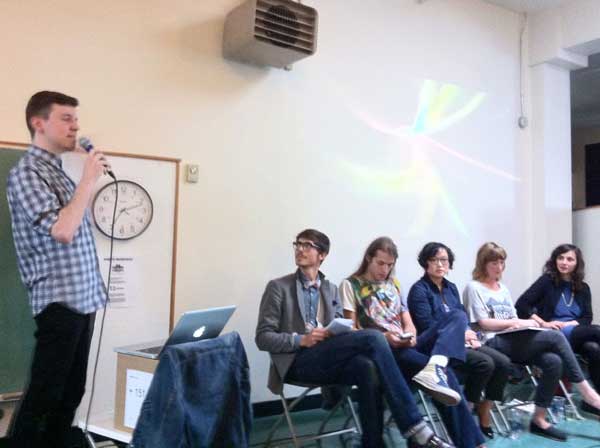Fresh Media is a group of Vancouverites who celebrate innovation and independent media. A project of OpenMedia.ca, their aim is to re-imagine and re-create what Canada’s media-scape looks like. This past Monday, the team held their 6th ReMixology event at the recently opened Vinegar Warehouse near Raymur and E Cordorva Street in Vancouver. ReMixiology is a series of events where media innovators and social change makers mix it up and look at ways to promote social change. Spacing Vancouver was a proud media sponsor of the event.
Edition #6 was of special interest to Spacing readers as it focused on “taking media to the street.” The central theme of the evening was “What happens when media in public space is remixed?” The event looked at how both old AND new media tools can be used affect public space and generate conversations in order to promote critical thinking and civic engagement.
The evening was moderated by Tyler Morgenstern, a coordinator of Media Democracy Day. Tyler opened the discussion by asking two provocative questions:
- How does/can media act IN a public space?
- How does/can media act AS a public space?
He then turned it over to the panel assembled for the event.
The first two panelists focused on creating community in real time and ‘real space.’ First up was Alexander Biko McNaughton who talked about his work in creating vibrant public spaces in Vancouver through crowd sourced public art and community gardening. Alexander touched on the intersection of the physical and virtual world when he mentioned Foodtree. Foodtree is a Vancouver-based mobile app that helps users to understand where their food comes from, who produces it, and who handles it as it travels from its source to their plate.
Techie turned music promoter, David Mattatal was up next. David discussed his Zoo Zhop Record Store and Space. The Zoo Zhop is also home to the Safe Amplification Site Society—a permanent all-ages space for music and other arts events in Vancouver. David noted that public performance spaces are important as they enable communities to share common experiences.
The second group of panelists talked about projects that bridged the physical and online worlds. Debra Zhou, the assistant curator at Centre A discussed Map Sense. Map Sense is a community-generated map that gives a multi-sensory view of a neighbourhood. The inaugural version focuses on Vancouver’s Downtown Eastside and Chinatown. Coined ‘socio-experiential mapping,’ the project features a mix of photograph, video, poetry and non-fiction entries. Each was contributed community members and described a specific place in their neighborhood.
Jenifer Paperer the curator at Vancouver’s Contemporary Art Gallery was up next. Jenifer was joined by Hannah Hughes. They discussed artist’s Ron Tran’s A Way to Go project. Tran’s work explores new ways of looking at daily life and the nature of social exchanges. Part of the project is an interactive walking tour of alternatives routes through the city. Tour participants use mobile devices to experience the artist observations along the route. In doing so, it transforms media from simply observing public space to being a public space in and of itself, addressing Tyler’s framing questions.
Overall, ReMixology 6 was an engaging and thought-provoking evening. The panelists were passionate about contributing to our public space and encouraging dialogue in the community. While they each took a unique approach to how we use public space, they all promoted the need for both critical thinking and civic engagement.
Please take the time and explore the links above in detail. Each will give you new insights into Spacing’s mission of ‘understanding the urban landscape.’ And stay tuned for details of the next ReMixology event, tentatively scheduled for the fall.
***


